There are a variety of different schools of thought on QB mechanics but there are enough reoccurring themes in them that it’s possible to pick out the movements, extensions, and positions that are most important. The following will be a summary of the aforementioned aspects of QB mechanics and I will show those mechanics (or lack thereof) in the throwing motions of Marcus Mariota, Jameis Winston, and some current NFL QBs. “ Pre Pass Triangle/Ball Carriage The kinetic chain in the arm starts in the Pre Pass Triangle position. With the elbows level at the base and a loaded wrist in the “cocked” position off the back shoulder, the triangle shape provides for a powerful position to launch the football. If the body was going to throw a punch it would load the arm instinctually in the same position. The Pre Pass Triangle position reduces tendency to internally rotate on the throw, aligns arm in a power position, and reduces wasted motion for faster release. (Link 1)

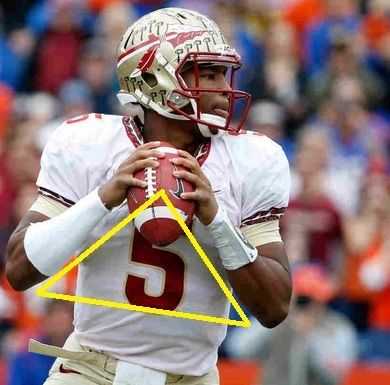
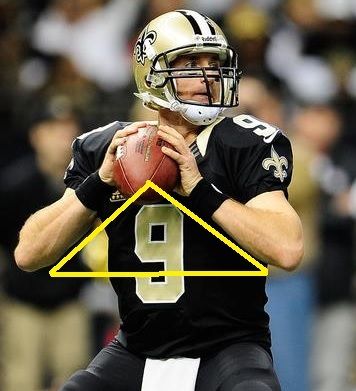
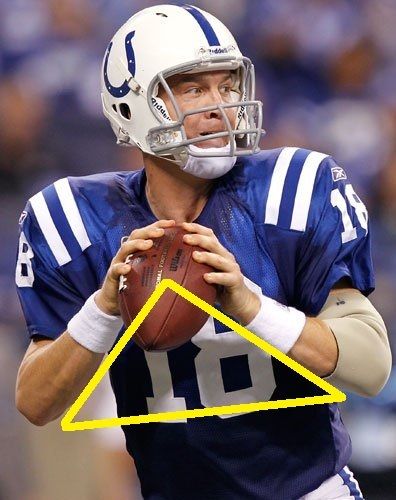
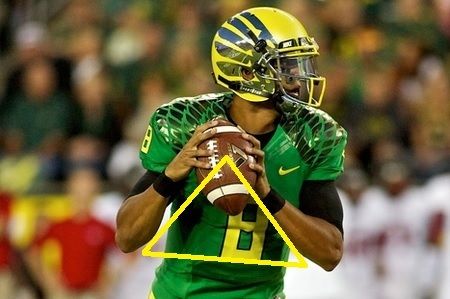 A correct and consistent carriage will provide your QB the initial environment needed to produce a repeatable arm circle. Right handed QBs should carriage the ball comfortably on their right peck with elbows relaxed and pointed toward the ground. You do not want the ball too close to the body, nor extended too far from the chest. A ball held too close to the chest will impede the initiation of the throwing motion. Holding the ball too far away from the chest will cause balance issues and tend to draw your QB’s upper body toward their toes. Upper body posture is very important to the carriage, throughout the drop back and any step-ups or reset. Consistent carriage and upper body posture will provide a consistent platform to trigger the throwing motion (Link 2). Summary: Neither Marcus Mariota nor Jameis Winston have much of an issue with this. Target Line, the short step, and getting the hip clear to the target The step should be short and across the target line just to the inside of the plant step. This shorter step will keep the throwing motion quick, compact, and allow the athlete to use more of his legs and shoulders during the throwing motion, thereby increasing the accuracy and velocity of the trajectory. (Link 3)
A correct and consistent carriage will provide your QB the initial environment needed to produce a repeatable arm circle. Right handed QBs should carriage the ball comfortably on their right peck with elbows relaxed and pointed toward the ground. You do not want the ball too close to the body, nor extended too far from the chest. A ball held too close to the chest will impede the initiation of the throwing motion. Holding the ball too far away from the chest will cause balance issues and tend to draw your QB’s upper body toward their toes. Upper body posture is very important to the carriage, throughout the drop back and any step-ups or reset. Consistent carriage and upper body posture will provide a consistent platform to trigger the throwing motion (Link 2). Summary: Neither Marcus Mariota nor Jameis Winston have much of an issue with this. Target Line, the short step, and getting the hip clear to the target The step should be short and across the target line just to the inside of the plant step. This shorter step will keep the throwing motion quick, compact, and allow the athlete to use more of his legs and shoulders during the throwing motion, thereby increasing the accuracy and velocity of the trajectory. (Link 3) 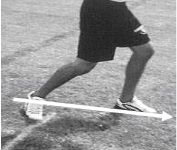 The stride length should not be too long . The short stride keeps the QB upright and over the top in his delivery. Most long stride QBs seem to have a problem keeping their elbow above their shoulder and never seem to have the nice high release. Point two concerning the stride deals with landing the stride just outside of the target line. This allows the QB to clear his hips and point them at the target and keeps the front hip from blocking the torso. This blocking of the torso inevitably causes the arm to slide away from the shoulder and body (Link 2)
The stride length should not be too long . The short stride keeps the QB upright and over the top in his delivery. Most long stride QBs seem to have a problem keeping their elbow above their shoulder and never seem to have the nice high release. Point two concerning the stride deals with landing the stride just outside of the target line. This allows the QB to clear his hips and point them at the target and keeps the front hip from blocking the torso. This blocking of the torso inevitably causes the arm to slide away from the shoulder and body (Link 2) 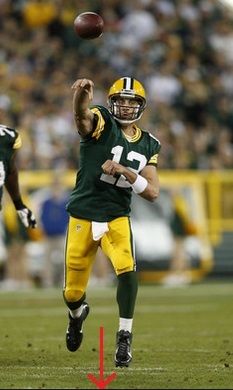


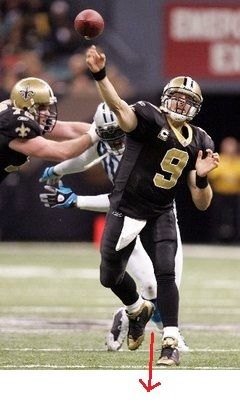
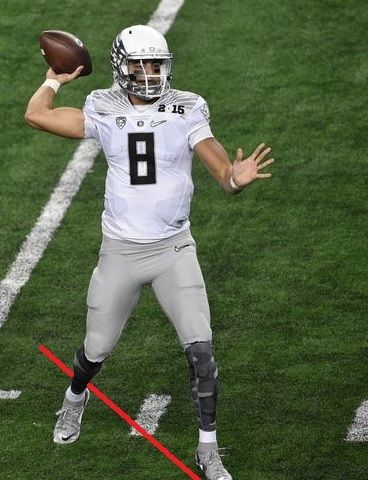 Summary: Generally, Winston and Mariota both do a good job with their footwork but Winston has the reoccurring problem of taking too long of a stride resulting in too much spacing between his feet, reducing his accuracy. Mariota will also throw from a wide base sometimes with too much spacing between the plant foot and the target step.
Summary: Generally, Winston and Mariota both do a good job with their footwork but Winston has the reoccurring problem of taking too long of a stride resulting in too much spacing between his feet, reducing his accuracy. Mariota will also throw from a wide base sometimes with too much spacing between the plant foot and the target step. 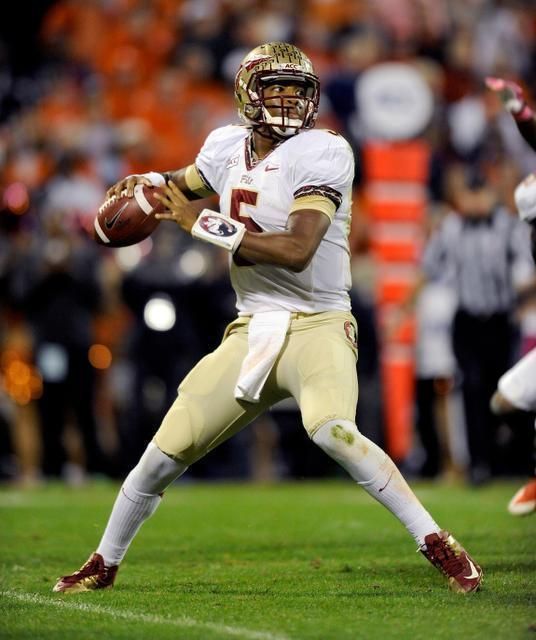 The short circle to the Loaded (“L”) Position Once the QB has begun the correct stride and has his hips opening to the target, the arm cycle is triggered. Ideally it is a compact short circle from the carriage to a loaded position. The ball should not drop below the chest; ideally the QB should push the ball up and back away from the peck. This will shorten the arm action and quicken the release time. Once the front hand breaks from the ball, it is now a race to the receiver between the ball and the defender. Here we can use the non-throwing hand to help initiate the arm circle and push the ball up and back as we break the carriage (Link 2). Summary: Mariota’s circle is tight and compact but this is obviously where Jameis Winston struggles the most. Instead of pushing the ball up and away from the triangle position, Winston drops the ball towards the waist, then raises it back up past the peck. While it doesn’t have any impact on velocity, accuracy, or trajectory, it does slow down the entire process.
The short circle to the Loaded (“L”) Position Once the QB has begun the correct stride and has his hips opening to the target, the arm cycle is triggered. Ideally it is a compact short circle from the carriage to a loaded position. The ball should not drop below the chest; ideally the QB should push the ball up and back away from the peck. This will shorten the arm action and quicken the release time. Once the front hand breaks from the ball, it is now a race to the receiver between the ball and the defender. Here we can use the non-throwing hand to help initiate the arm circle and push the ball up and back as we break the carriage (Link 2). Summary: Mariota’s circle is tight and compact but this is obviously where Jameis Winston struggles the most. Instead of pushing the ball up and away from the triangle position, Winston drops the ball towards the waist, then raises it back up past the peck. While it doesn’t have any impact on velocity, accuracy, or trajectory, it does slow down the entire process. 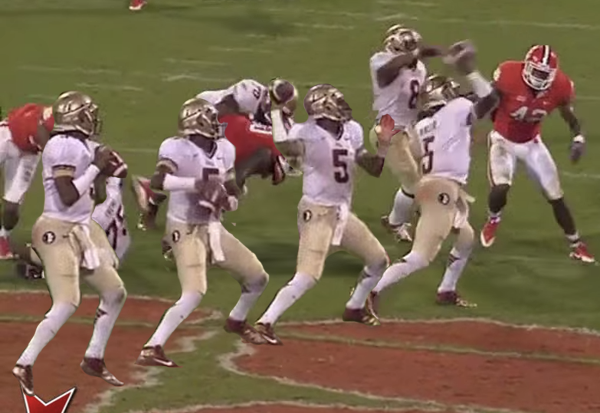
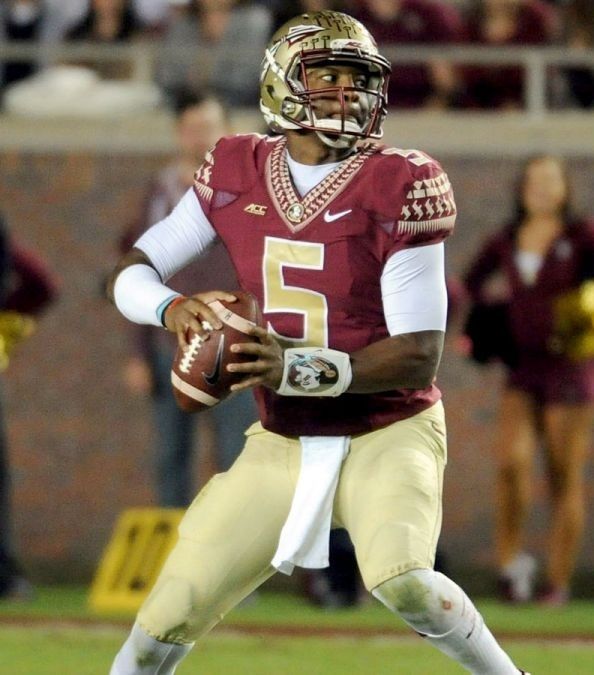
 “L” – Position This is the next position in the kinetic chain during the throw. The move to this position is done by using the 4 rotator cuff muscles that surround the scapula. The infrasprinatus and teres minor externally rotate the arm back into the “L” position. When the arm is in the “L” position it elongates the suprasprinatus and subscapularis which allow the muscles to accelerate the elbow to the lead position (Link 1).
“L” – Position This is the next position in the kinetic chain during the throw. The move to this position is done by using the 4 rotator cuff muscles that surround the scapula. The infrasprinatus and teres minor externally rotate the arm back into the “L” position. When the arm is in the “L” position it elongates the suprasprinatus and subscapularis which allow the muscles to accelerate the elbow to the lead position (Link 1). 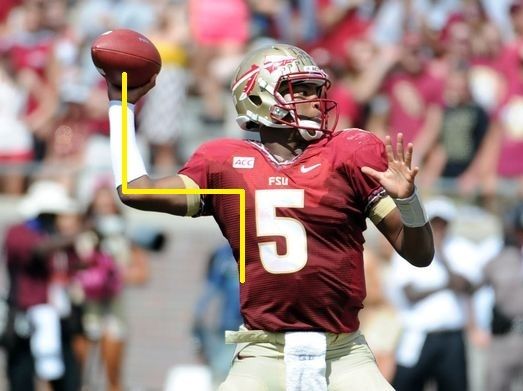
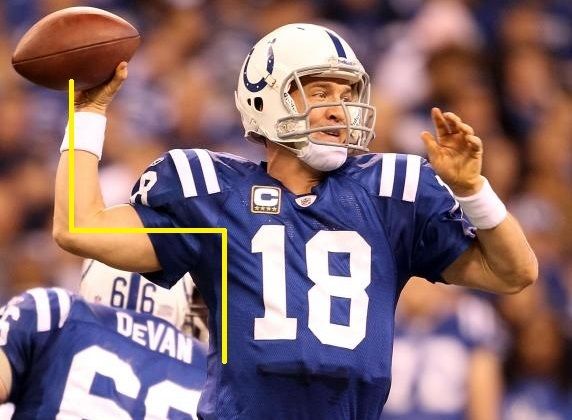
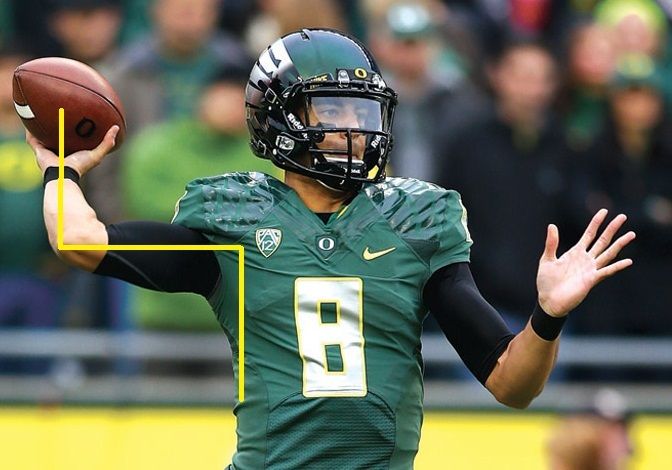 Summary: Both Winston and Mariota achieve a textbook “L” Position. Elevate to “Zero” This the lead position the elbow has to be in to support the wrist. You may have heard coaches say “get the elbow up”. The elbow only needs to go high enough to get over and ahead of the shoulder on the throw. The smoothness and efficiency of this move is the key to consistent power and accuracy on a throw. With the loading of the suprasprinatus and subscapularis muscles in the “L” position the elbow can now elevate and move ahead of the shoulder aided by the deltoid to get to “Zero”. “Zero” is orthopedic term given to the elbow in the lead position because the rotator cuff muscles are neutral with no strain on them. The “Zero” position places the elbow 6 inches ahead of the shoulder, 45 degrees up, and out and loads the tricep in a position to fire the ball down the target hallway (Link 1).
Summary: Both Winston and Mariota achieve a textbook “L” Position. Elevate to “Zero” This the lead position the elbow has to be in to support the wrist. You may have heard coaches say “get the elbow up”. The elbow only needs to go high enough to get over and ahead of the shoulder on the throw. The smoothness and efficiency of this move is the key to consistent power and accuracy on a throw. With the loading of the suprasprinatus and subscapularis muscles in the “L” position the elbow can now elevate and move ahead of the shoulder aided by the deltoid to get to “Zero”. “Zero” is orthopedic term given to the elbow in the lead position because the rotator cuff muscles are neutral with no strain on them. The “Zero” position places the elbow 6 inches ahead of the shoulder, 45 degrees up, and out and loads the tricep in a position to fire the ball down the target hallway (Link 1). 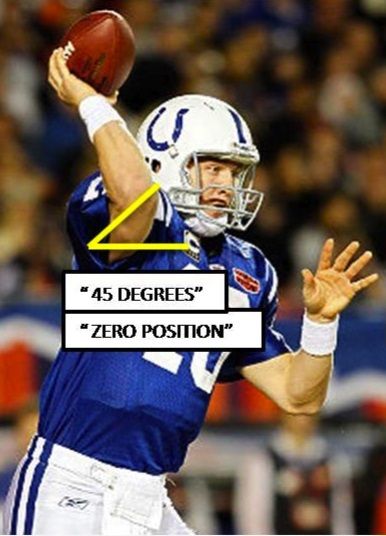
 Summary: Mariota does a great job achieving this position. Winston, instead of having the elbow up and ahead of the shoulder, will often keep it parallel with the shoulder (more on this later). Triple Extension Outward and Upward Power is force divided by time. The most amount of force in the least amount of time equals maximum power. The shorter radius of the arm, created by collapsing the elbow, generates higher velocity in a much shorter amount of time, creating a more powerful throw. However, this potential energy is not effectively realized until the arm extends as quickly and fully as possible, maximizing the power generated before the ball is released. When referring to the body, power is exerted through straight lines. Think of a punch with a bent arm, or a jump with bent legs; minimal power. But when a limb that is bent at its joints rapidly extends, maximum power is expressed at the moment those joints are extended in a synchronized effort. Extending the throwing arm completely, and firing the wrist at the exact moment of triple extension, maximizes power, accuracy, and spiral of the football (Link 4).
Summary: Mariota does a great job achieving this position. Winston, instead of having the elbow up and ahead of the shoulder, will often keep it parallel with the shoulder (more on this later). Triple Extension Outward and Upward Power is force divided by time. The most amount of force in the least amount of time equals maximum power. The shorter radius of the arm, created by collapsing the elbow, generates higher velocity in a much shorter amount of time, creating a more powerful throw. However, this potential energy is not effectively realized until the arm extends as quickly and fully as possible, maximizing the power generated before the ball is released. When referring to the body, power is exerted through straight lines. Think of a punch with a bent arm, or a jump with bent legs; minimal power. But when a limb that is bent at its joints rapidly extends, maximum power is expressed at the moment those joints are extended in a synchronized effort. Extending the throwing arm completely, and firing the wrist at the exact moment of triple extension, maximizes power, accuracy, and spiral of the football (Link 4). 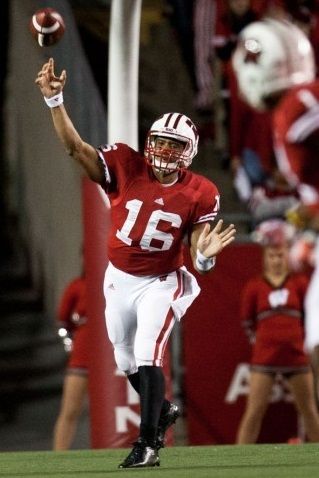
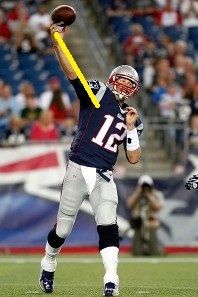 Summary: Jameis Winston and Marcus Mariota can both achieve triple extension while on the run which is good because footwork generally goes out the window.
Summary: Jameis Winston and Marcus Mariota can both achieve triple extension while on the run which is good because footwork generally goes out the window. 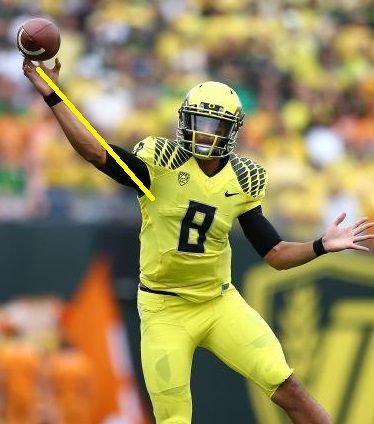
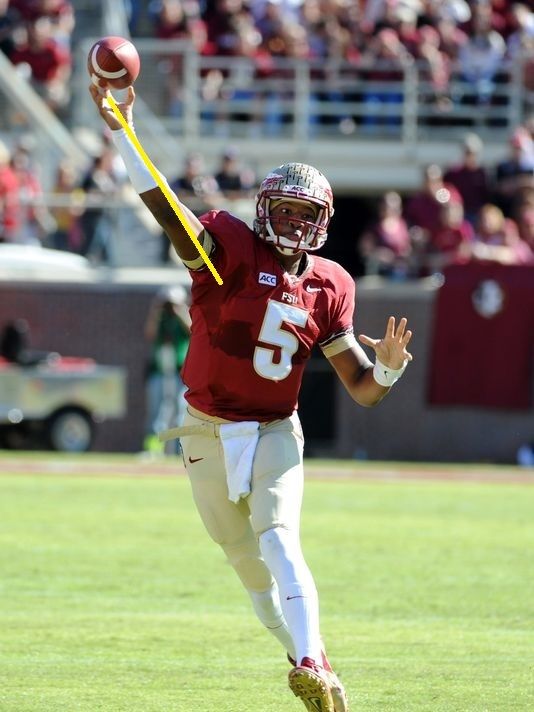 In the pocket, Mariota is great as well. He completely extends the ball up and away from his body.
In the pocket, Mariota is great as well. He completely extends the ball up and away from his body.  With set feet in the pocket, Winston generally does not achieve triple extension. While he is capable of it (second photo), he usually fails to completely collapse the elbow.
With set feet in the pocket, Winston generally does not achieve triple extension. While he is capable of it (second photo), he usually fails to completely collapse the elbow. 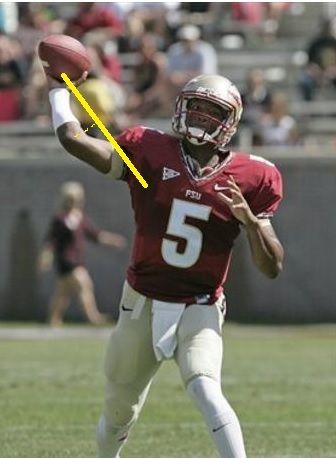
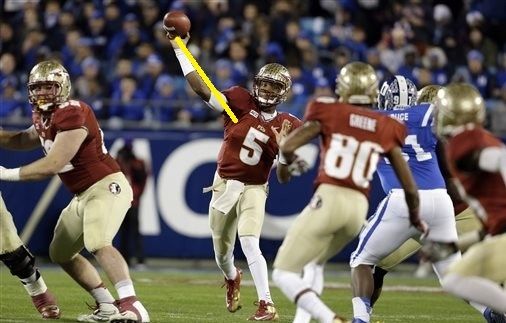 My theory on why this happens is summarized in the photo below…
My theory on why this happens is summarized in the photo below…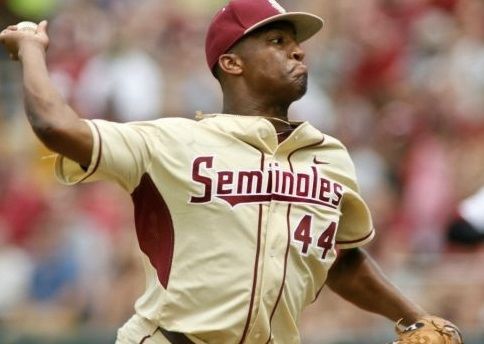 If he ends up being the Buccaneer’s pick, here’s hoping that the removal of pitching from his annual routine will allow him to learn to straighten out his arm because I do think it impacts his power and accuracy. Maintaining Extension and Stepping into the Throw As the arm continues to move forward, it is important to keep it fully extended to get the full benefit of the tricep and put the maximum amount of velocity on the arm (Link 1).
If he ends up being the Buccaneer’s pick, here’s hoping that the removal of pitching from his annual routine will allow him to learn to straighten out his arm because I do think it impacts his power and accuracy. Maintaining Extension and Stepping into the Throw As the arm continues to move forward, it is important to keep it fully extended to get the full benefit of the tricep and put the maximum amount of velocity on the arm (Link 1). 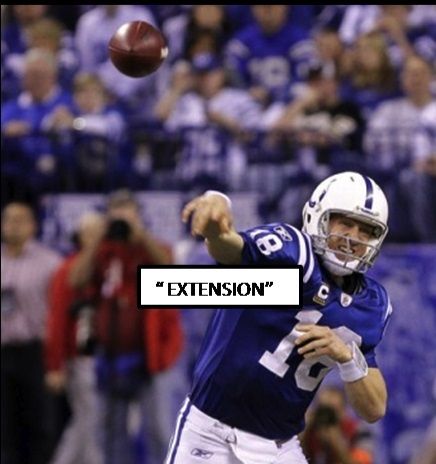
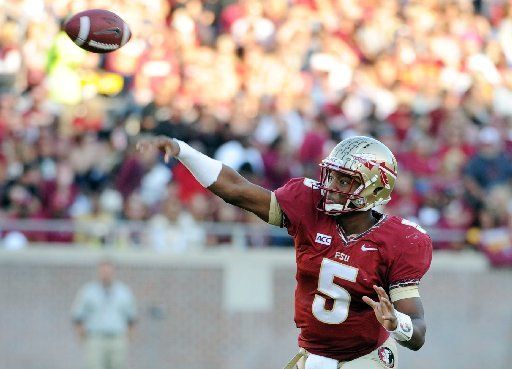
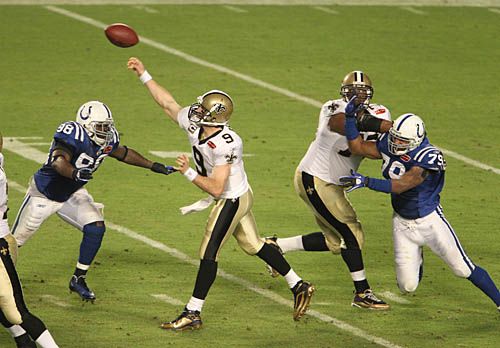 Summary: Both Winston and Mariota do a good job of this but I couldn’t find a good picture for Mariota and all my video captures were extremely poor quality. As the arm moves forward, the majority of the power should come from the plant leg. The target foot should be firmly planted and the plant foot should move forward until it is nearly parallel with the target foot (Link 3). Some see it as detrimental to raise the plant leg off the ground as it moves forward, but I heard Kurt Warner say during the combine coverage that he doesn’t think that matters as long as the power is still coming from the leg. I’ve noticed that some of the best QBs in the league raise their leg off the ground and some don’t. Which confirms Warner’s assertion that It doesn’t make much of a distance. As the plant legs move forward and the ball leaves the hand of the extended arm, the shoulders should spin and the throwing hand should pronate (palm down) as it ends up in the opposite front pocket area. This maximizes the rotation and velocity of the ball (Link 3).
Summary: Both Winston and Mariota do a good job of this but I couldn’t find a good picture for Mariota and all my video captures were extremely poor quality. As the arm moves forward, the majority of the power should come from the plant leg. The target foot should be firmly planted and the plant foot should move forward until it is nearly parallel with the target foot (Link 3). Some see it as detrimental to raise the plant leg off the ground as it moves forward, but I heard Kurt Warner say during the combine coverage that he doesn’t think that matters as long as the power is still coming from the leg. I’ve noticed that some of the best QBs in the league raise their leg off the ground and some don’t. Which confirms Warner’s assertion that It doesn’t make much of a distance. As the plant legs move forward and the ball leaves the hand of the extended arm, the shoulders should spin and the throwing hand should pronate (palm down) as it ends up in the opposite front pocket area. This maximizes the rotation and velocity of the ball (Link 3). 
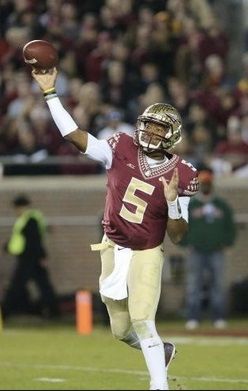
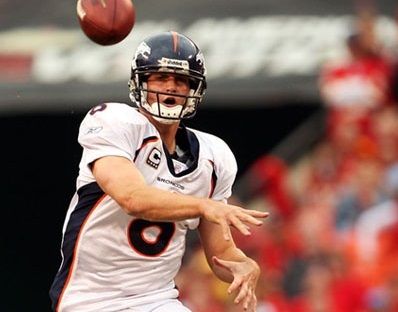
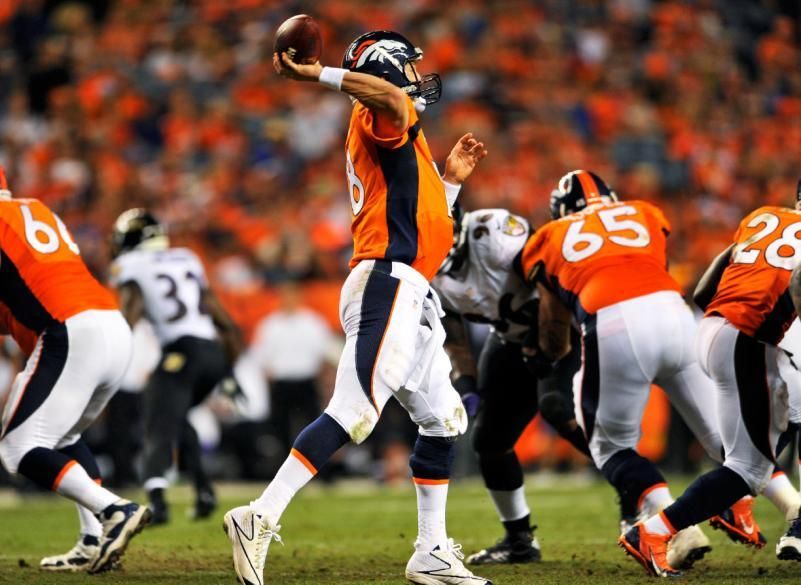
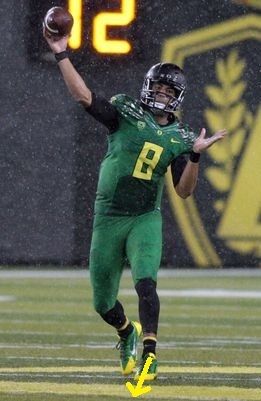
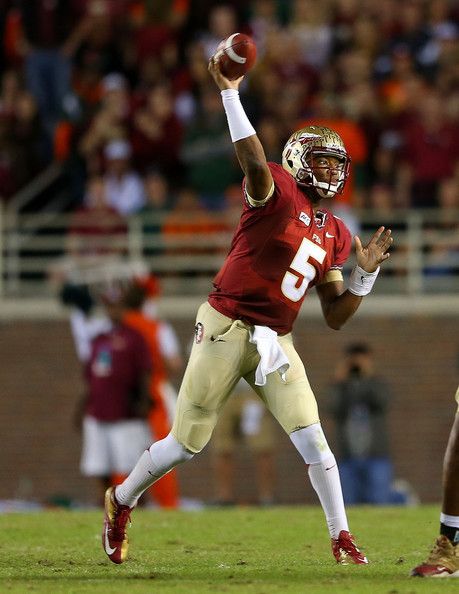
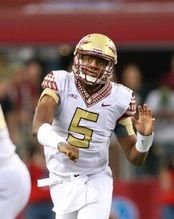

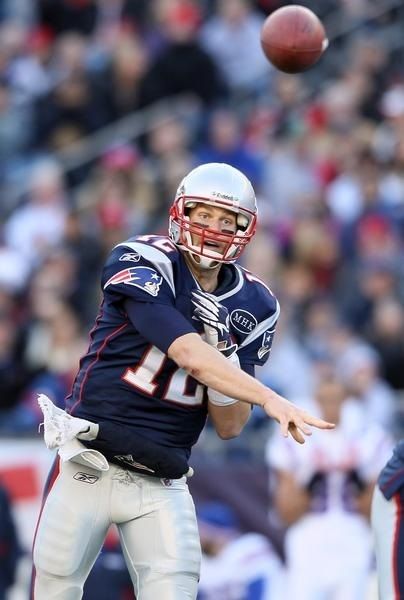
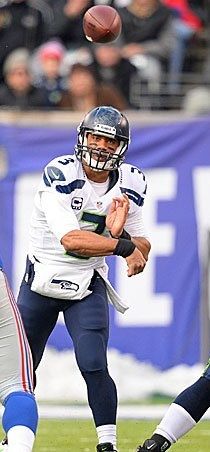 Summary: Mariota is textbook on this and has great mechanics as he completes the motions. Even on the run, Mariota will blast off the plant leg to increase the power of his throws.
Summary: Mariota is textbook on this and has great mechanics as he completes the motions. Even on the run, Mariota will blast off the plant leg to increase the power of his throws. 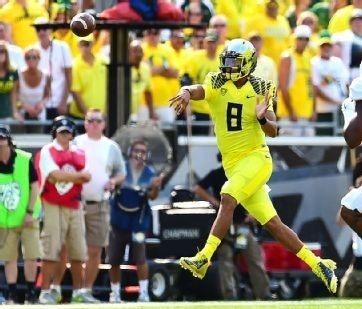 Winston spins the shoulders and rotates the throwing hand but sometimes he doesn’t maximize the power of his throws by pushing the plant foot completely forward. Instead he will muscle the throw solely with his upper body. Mechanical Breakdowns Mariota rarely has mechanical breakdowns. I don’t think anyone should have any grave concerns with his throwing mechanics. However, it’s difficult to project what will happen to Mariota’s mechanics when pressured in the NFL. His elite speed in college usually allowed him to break away and throw on the run or escape and completely reset his base. In the face of interior pressure, Winston’s footwork can get sloppy. He will often throw the ball off his back foot without establishing proper target foot positioning. He will also throw with his feet perpendicular to one another forcing him to generate power exclusively with his upper body and arm.
Winston spins the shoulders and rotates the throwing hand but sometimes he doesn’t maximize the power of his throws by pushing the plant foot completely forward. Instead he will muscle the throw solely with his upper body. Mechanical Breakdowns Mariota rarely has mechanical breakdowns. I don’t think anyone should have any grave concerns with his throwing mechanics. However, it’s difficult to project what will happen to Mariota’s mechanics when pressured in the NFL. His elite speed in college usually allowed him to break away and throw on the run or escape and completely reset his base. In the face of interior pressure, Winston’s footwork can get sloppy. He will often throw the ball off his back foot without establishing proper target foot positioning. He will also throw with his feet perpendicular to one another forcing him to generate power exclusively with his upper body and arm. 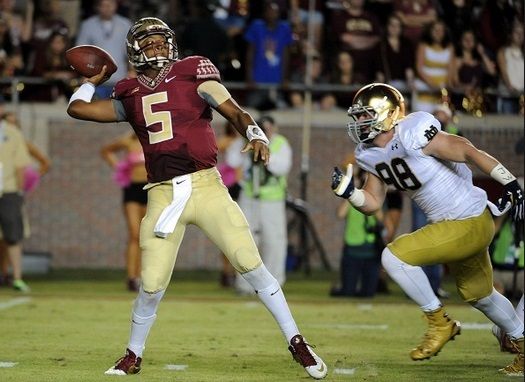
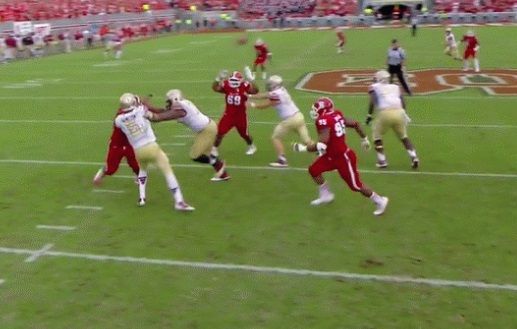 Thankfully, neither of these guys have complete mechanical breakdowns in a clean pocket. As stated above, Winston will occasionally fail to drive his plant leg forward (as evidenced on his first two interceptions against Florida) but the kinetic movement of his hips and arm will remain intact. Guys like Matthew Stafford and especially Jay Cutler will have a relatively clean pocket and completely botch the foot work, kinetic arm movement, and extension.
Thankfully, neither of these guys have complete mechanical breakdowns in a clean pocket. As stated above, Winston will occasionally fail to drive his plant leg forward (as evidenced on his first two interceptions against Florida) but the kinetic movement of his hips and arm will remain intact. Guys like Matthew Stafford and especially Jay Cutler will have a relatively clean pocket and completely botch the foot work, kinetic arm movement, and extension. 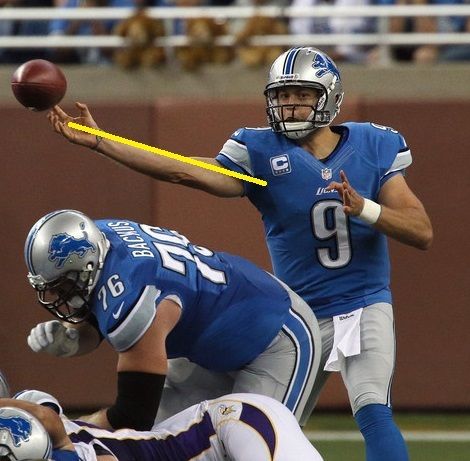
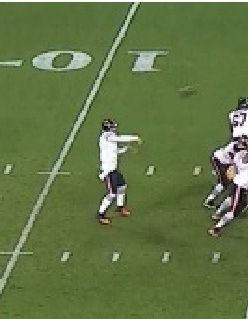
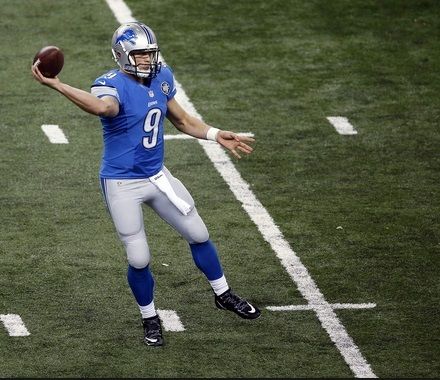

 In summary, I think Marcus Mariota has flawless mechanics. In the grand scheme of things, Winston’s elongated circle doesn’t matter because the rest of his kinetic arm motions are pretty good. It will be interesting to see if becoming a one sport athlete will remove the cocked elbow from his triple extension. The best thing he can do as he transitions to the next level will be to learn to consistently drive his plant leg forward.
In summary, I think Marcus Mariota has flawless mechanics. In the grand scheme of things, Winston’s elongated circle doesn’t matter because the rest of his kinetic arm motions are pretty good. It will be interesting to see if becoming a one sport athlete will remove the cocked elbow from his triple extension. The best thing he can do as he transitions to the next level will be to learn to consistently drive his plant leg forward. 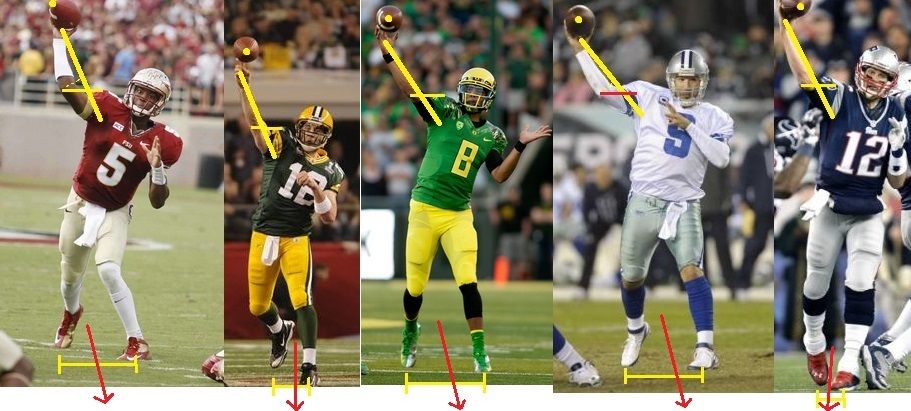 Sources:Link 1 : http://smartfootball.com/quarterbacking/can-a-quarterbacks-throwing-motion-be-improved#sthash.Ir9RdNJI.dpbs Link 2: http://xandolabs.com/index.php?option=com_content&view=article&id=872:825-check-points-for-improving-qb-throwing-mechanics&catid=94&Itemid=162 Link 3: http://www.topgunqbacademy.com/PDFsVideo/QB_LB.pdf Link 4: http://www.authorityfootball.com/x-and-o-labs-and-the-quarterback-mechanic/
Sources:Link 1 : http://smartfootball.com/quarterbacking/can-a-quarterbacks-throwing-motion-be-improved#sthash.Ir9RdNJI.dpbs Link 2: http://xandolabs.com/index.php?option=com_content&view=article&id=872:825-check-points-for-improving-qb-throwing-mechanics&catid=94&Itemid=162 Link 3: http://www.topgunqbacademy.com/PDFsVideo/QB_LB.pdf Link 4: http://www.authorityfootball.com/x-and-o-labs-and-the-quarterback-mechanic/
ForumVisual Realm2023-04-26T12:12:17-04:00
Notifications
Clear all
Topic starter
Posted : Feb. 23, 2015 4:09 am
